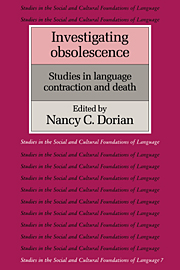Book contents
- Frontmatter
- Contents
- List of maps
- List of contributors
- Preface
- Map
- Dedication
- Introduction
- I Focus on context
- II Focus on structure
- III Invited commentaries
- 21 Some people who don't talk right: Universal and particular in child language, aphasia, and language obsolescence
- 22 Language obsolescence and language history: Matters of linearity, leveling, loss, and the like
- 23 Language convergence and language death as social processes
- 24 Pidgins, creoles, immigrant and dying languages
- 25 The “up” and “down” staircase in secondary language development
- Bibliography
- Index of languages
- General index
23 - Language convergence and language death as social processes
Published online by Cambridge University Press: 08 January 2010
- Frontmatter
- Contents
- List of maps
- List of contributors
- Preface
- Map
- Dedication
- Introduction
- I Focus on context
- II Focus on structure
- III Invited commentaries
- 21 Some people who don't talk right: Universal and particular in child language, aphasia, and language obsolescence
- 22 Language obsolescence and language history: Matters of linearity, leveling, loss, and the like
- 23 Language convergence and language death as social processes
- 24 Pidgins, creoles, immigrant and dying languages
- 25 The “up” and “down” staircase in secondary language development
- Bibliography
- Index of languages
- General index
Summary
Linguistic conservatism and language maintenance
An intriguing question that echoes through many of the studies in this volume is whether there is a relationship between linguistic conservatism or corruption and language maintenance or death. The relationship between persistence of form and persistence of use can be phrased and questioned in two directions. The functional linguist asks whether, when we know that a language has undergone contraction in number of speakers or domains of use, we can predict certain types of changes in linguistic structure as a consequence. The editor of this volume has led in formulating and investigating that question (e.g. Dorian 1981, 1986c), and articles in the second section of this volume in particular bring important evidence to bear on the issue.
A different ordering of the variables gives rise to a different question, one of considerable interest to those readers concerned with the social, political, and social-psychological processes of language maintenance and shift, those of us still struggling to understand how the battery of factors that seem to overwhelm minority languages combine to produce their effects, or occasionally are turned back. The question is raised and confronted most directly in Eric Hamp's linguistically erudite review of phonological change in dying languages, but it is a question that is fundamentally about the social processes underlying language change and language loss. That question is whether, when we find interference or convergence phenomena in the structure of a language in contact with others, we should necessarily see these as signs that shift is in progress and loss impending.
Information
- Type
- Chapter
- Information
- Investigating ObsolescenceStudies in Language Contraction and Death, pp. 355 - 368Publisher: Cambridge University PressPrint publication year: 1989
Accessibility standard: Unknown
Why this information is here
This section outlines the accessibility features of this content - including support for screen readers, full keyboard navigation and high-contrast display options. This may not be relevant for you.Accessibility Information
- 25
- Cited by
